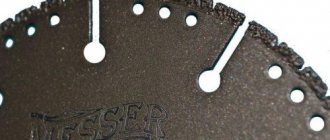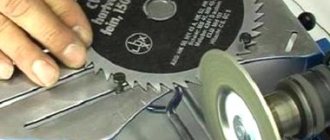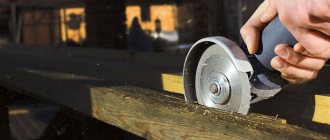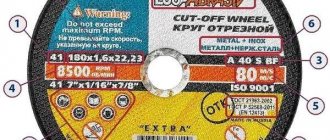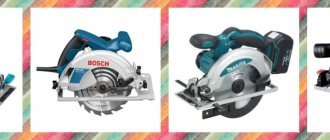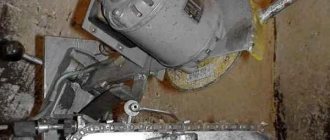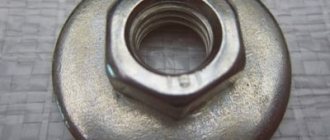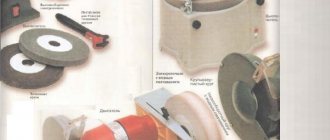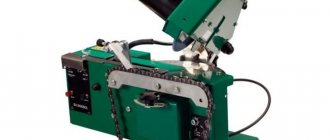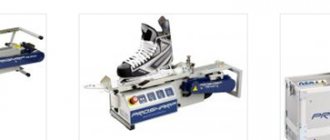Depending on the type of disk, the following can be processed:
- wood of various species;
- polymeric substances and products made from them, for example, plexiglass, polystyrene;
- products based on iron alloys - pipes, corrugated sheets, etc.
- wood products - chipboard, OSB, plywood, laminate and other similar materials;
- natural stone material, such as marble;
- soft metals - aluminum, copper alloys;
A cutting tool has certain characteristics, parameters, dimensions, purpose, and properties of the material from which it is made.
Main characteristics of equipment
When choosing the right drive for your machine, there are a number of important factors to consider that affect performance. The main technological indicators are:
- Electric motor power. To fit a large diameter saw blade, you need to turn the motor as high as possible. The disadvantage of such devices is their weight. For example, a device with a 1200 W electric motor weighs about 4 kg. The most powerful system with a power of 2000 W already weighs 7 kg.
- Depth. To get a long cut of a certain depth, it is very important to choose the right power.
Disk rotation speed. This parameter is directly proportional to the density of the workpiece. The cut will be clean if the rotation speed is very high.
disc on a miter saw
Adjusting the angle of inclination. Many saw models have this setting. If you often cut at an angle, then you need to take a disk with a thickness of more than 2.5 mm.
Thinner discs will bend when cutting at an angle and it will not be possible to make an accurate cut.
Basic parameters of a circular saw blade
Outer (external) diameter
it is determined by the internal size of the guard - a large diameter blade will not fit a saw with a smaller guard. The main dimensions of the cutting tool for portable circular saws are from 130 to 250 mm.
saw blade installation
The outer diameter does not significantly affect the cutting speed, but determines the depth of cut.
As the cut increases, the engine is significantly loaded, the metal of the blade and the workpiece itself heat up.
Internal, landing diameter
It has several sizes: 16, 20, 22, 30, 32. An important parameter is that the diameter must correspond to the size of the motor shaft on the saw for which the blade is selected. Some disc models have additional holes that secure the disc to pins.
Dewalt saw blade
Some discs come with a special adapter washer for different shaft diameters.
Number of teeth on the disc
This affects parameters such as cutting speed and cleaning. With a decrease in the number of teeth, the processing speed increases, the conditions for chip evacuation improve, but the cutting cleanliness deteriorates. As the number of teeth increases, the cut becomes cleaner, but the load on the engine increases. Conventionally, according to their quantitative ratio, disks can be divided into three groups:
- a large number of incisors - from 80 to 90 pcs.;
- average quantity (40-80 pcs.);
- small amount (10-40 teeth).
Disks with an average number of cutters are classified as universal. They can process soft and hard wood, make cross and longitudinal cuts, and can be used for processing various wood products.
Tooth inclination
Determined by the deviation of the cutting edge surface from the radius of the disk. When the deviation is toward the back of the tooth, the inclination is called negative, and when the inclination is on the opposite side, it is called positive.
parquet saw blade
For longitudinal sawing, it is more appropriate to use a tooth with a positive inclination, since during processing a kind of material capture occurs, which contributes to faster cutting of the workpiece.
The photo shows a good and reliable Dewalt blade for a parquet saw.
Based on the inclination of the tooth, they are divided into:
- standard tilt: angle varies from 5° to 15°;
- positive and aggressive slope 15-20°;
- a typical negative angle ranges from 0° to -5°.
Tooth configuration
Each type of cutter is designed and built to solve a specific problem. Divided into:
- Flat cutter - used for fast rip cutting of soft or hard wood, designated FT.
- A combination cutter is a sequential change of groups from a combination of four replaceable cutters (ATB) and one flat cutter (FT). Combi. This type of blade is designated as a multi-purpose blade due to its ability to perform different types of cuts.
- High bevel interchangeable tool - designed for cutting materials prone to cracking and for fine cross cuts. Designated HiATB.
- Replaceable cutter - has a replaceable sequentially alternating inclination of the teeth in one direction or another. The cutters produce a uniform and fairly clean cut. It is used for cross and rip cuts in wood, plywood, OSB, chipboard and composite panels marked with the ATB symbol.
- A flat trapezoidal cutter consists of flat teeth following one another. The higher one is sharp and trapezoidal, the lower one is flat. Used for processing wood and wood products, polymer materials and soft non-ferrous metals. Designated TCG.
Disc thickness
Determine the actual cut. The standard size is 3.2 mm.
parquet saw blade
The thinner the blade, the faster it cuts. But a good cut with such a disk can only be made across the wood fibers.
Thin disks, 1-1.5 mm thick, are usually installed on cordless saws. At an angle, such a disc will not cut well.
Important Features
So that readers do not get lost in the wilds of the modern market for accessories for circular saws, we have prepared 5 main criteria that will help you make your choice. Let's consider them in order of importance.
External diameter
The outer or outer diameter of the disk should not exceed the dimensions of the circular saw casing, otherwise it will not be possible to install it in the seat. Increasing the parameter leads to an increase in the depth of cut. The characteristics vary from 65 to 500 mm.
Landing diameter
Landing, or internal diameter - the size of the hole in the center of the equipment. Determines whether the saw blade will fit on the spindle. The most popular sizes: 16 , 20 , 22 , 30 and 32 mm. But the full range is much wider - from 11 to 50 mm.
Manufacturers may install pins on the saw seat for additional fixation . In this case, you need to choose a disk with appropriate holes .
Number of teeth
As the number of teeth increases the processing speed decreases , but the cleanliness of the cut improves . And vice versa: the fewer teeth, the faster the work goes , but the cut becomes less and less accurate . The characteristic has its own classification, presented in the table:
| № | Name | Number of teeth, pcs |
| 1 | Big | 80-90 |
| 2 | Average | 40-80 |
| 3 | Small | 10-40 |
Tooth sharpening angle
Sharpening inclination is the angle of deviation of the cutting edge of the tooth from the radius of the saw blade. The picture clearly shows how a characteristic can influence the work process. The angles are:
Standard : 5-15 °. Universal sharpening. Suitable for all types of cuts.
Positive : 15-20 °. Ideal for rip sawing due to its gripping effect.
Negative : from to – 5 °. Used for cross cutting, does not form chips.
Disc thickness
The standard parameter is 3.2 mm. The thinner the disk, the more it heats up and the faster it fails. The large thickness guarantees a long service life of the equipment, but slows down the work. In this case, the excess consumption of material increases due to the wide cut.
More about saw blades
Not only the quality and speed of the cut, but also human safety depends on the correct choice and use of the saw blade. So it makes sense to take a closer look at the features of popular models.
Cross and longitudinal sawing
Unlike cutting metal or stone, when working with wood, the direction of the cut is of great importance. This can be explained by the direction of the grain, so it works completely differently when cutting crosswise versus slitting.
The 210×30 and any other size slitting disc is designed to cut the workpiece along the fibers as quickly as possible. Among the design features, one can note an enlarged chest compared to other models (this is necessary for quickly removing a large amount of sawdust), as well as a smaller number of teeth.
The sharpening angle of the blade is positive, due to this the self-locking effect is maximized, that is, the saw attracts the workpiece to itself, which facilitates its feeding and increases work safety. If you need to cut a large volume of lumber with your own hands, this will greatly facilitate the work.
For cross cutting, a large positive sharpening angle is completely useless; it will only create additional problems.
The main difference between crosscut blades is the sharpening angle, which can also be negative if maximum control over the feed speed of the workpiece is required. You can also note the increased number of teeth and reduced size of the sinuses for removing sawdust.
This sharpening will give you maximum control over the progress of the workpiece.
In principle, a simple rule applies: the harder the material, the smaller the size of the tooth, but there are more of them on the disc.
Influence of tooth shape on cutting
The quality of the cut with a carbide blade is greatly influenced by the shape of the tooth.
There are such saw blade options as:
- The 190x30 blade with flat top teeth is ideal for cutting very hard wood. The tooth is symmetrical, so the load is even on both sides;
Flat top suitable for hardwoods
- blunt teeth: in such models, the upper part of the teeth is beveled in a checkerboard pattern in different directions. This allows you to effectively bite into the material, minimizing the possibility of chipping;
Adjustable tilt angle
It is not recommended to use this blade for cutting hard material. The fact is that when a tooth comes into contact with the shaft, a significant axial force will be created on it.
- "Triple chips." The disc works according to this scheme: first, one tooth with symmetrical bevels on the sides removes a triple chip, and the next one (with a flat top) cleans the edges of the cut. A 250x32 disc with this tooth configuration can be considered a universal solution; it is suitable for both plastic and hard wood;
Triple chip tooth configuration
- If you need ideal cutting quality, then you should pay attention to discs, where a block of 4 blunt teeth contains 1 tooth with a flat top. The main function of the cut falls on teeth with an oblique top and with a flat one - it will only clean the cut.
Monolithic and carbide wheels
Most often, the price of disks of the same standard size differs significantly. Most likely, the fact is that one of them is monolithic, and the second is carbide. This explains the difference in cost.
In a monolithic disk, the teeth are integral with the disk itself.
They are cheaper than carbide ones, but the low price is due to a number of disadvantages:
- they become dull faster, especially when working with hard wood;
- Over time, it is necessary to update the wiring, otherwise the cut will become too tight, which will lead to overheating and increased load on the motor.
The teeth and the disc itself are one whole
The advantages of such models include the fact that they can be sharpened several times. True, it is quite difficult to do this manually without experience.
For carbide-tipped blades, small metal inserts made of a high-strength alloy are welded to the top of the tooth.
This allows you to achieve several goals simultaneously:
- Due to the fact that the width of the weld exceeds the width of the disk itself, there is no need for wiring. This simplifies maintenance;
- The metal of the weld is much stronger than the metal of the disk itself, so it can be effectively cut for much longer than a monolithic one.
Visible hard metal welding
Sharpening is not recommended, but not necessary. If we compare the service life of 2 types of disks, it turns out that a monolithic disk will have to be sharpened 2-4 times, and a carbide disk will last all this time without sharpening.
So, when choosing, it all depends on the type of wood you are going to work with. So, if you need to choose a 165x20 disc for soft wood (poplar, linden, aspen), a monolithic one will do. But for oak or larch, maple, it makes sense to buy a carbide model.
Sharpening angle and tooth shape of circular saw
Sharpening angle and tooth shape of a circular saw
These are important factors affecting cutting speed and quality. For various materials, combined forms of cutters are used, for example, the first cutter cuts, the second cuts the surface in finishing. The angle of attack of the weld affects not only the cleanliness of the cut, but also the service life of the saw blade.
Table of saw blade teeth sharpening angles
negative sharpening angle
Negative sharpening angle of a circular saw tooth – for finishing cutting of chipboard or laminate.
Positive sharpening angle of the circular saw tooth - for high-speed cutting with average cut quality
positive tooth sharpening angle
positive tooth sharpening angle
Positive angle of sharpening of the teeth of a circular saw with variable teeth - for longitudinal and transverse cutting of wood and plywood, chipboard and fiberboard
Negative sharpening angle of the circular saw blade with feed limiter - does not allow exceeding the permissible feed speed
negative sharpening angle of the circular saw blade
positive sharpening angle of the circular saw blade
Positive sharpening angle of a circular saw blade with trapezoidal teeth - for cutting soft metals, plastics, chipboards
Recesses in the saw blade body are necessary to protect against overheating and absorb vibrations.
saw blade
Marking
As you can see in the picture, the disc markings can tell you about many technical characteristics. But there is a dependence that should not be neglected: the shape of the teeth directly affects the ability to work with a specific material.
The classification developed by representatives of the GASS divides discs into the following categories based on tooth shape :
GK and GS:p alternately beveled . Suitable for processing all types of wood and “clean” chipboards , without plywood and plastic coatings.
Read also: DIY hydraulic cylinder from a jack
GM : direct . They can only cope with cutting soft wood.
GT : trapezoidal . They are useful in cases where you need to cut MDF or chipboard with lamination.
GR : conical . Cuts multi-layer coatings with double lamination.
GA : trapezoidal and straight . Same features as GT .
laser markings to high-quality saw blades . If the parameters are “written” with ordinary paint , it means that we are looking at an economy-class product that will quickly become unusable.
We select a saw blade to solve a specific task
Each disc packaging indicates its specific use. Disks of relatively universal use are often found, for materials that are similar in structure and density. For example, for wood, chipboard, fiberboard, plywood.
saw blades for different materials
There are no good records “everywhere”. If the manufacturer claims that it is for wood, metal, concrete, and so on, then in the end such an item will not cut anything.
For wood
For basic and regular cuts, discs with large and rare teeth are suitable. For example, the outer diameter is 200 mm for 24 teeth. For clean teeth, diagonal, cross, medium and fine teeth are best.
For clean cutting of chipboard and laminate
For these materials, the smaller and more common the tooth, the less chips and scratches there will be. However, even in this case there is no guarantee of a perfect cut. These materials are sawed on special machines with a second scoring disc that rotates in the opposite direction.
On a regular circular saw, these materials can be cut without damage with the mentioned disk, but with preliminary cutting of the coating or by gluing the cut with protective adhesive tape.
For aluminum
Discs are used for metal. For example, for non-ferrous metals or thin steel. Such discs have fine teeth, a negative angle and are made of special steel for cutting metals.
Rating of the best
Sawing equipment is a popular (consumer) product. Therefore, there are many who want to fill this niche with their low-quality products. The problem is that there are manufacturers who counterfeit well-known brands.
It’s safer to choose discs from reputable brands that are protected from counterfeiting (holograms on the packaging, website addresses where you can confirm the origin of the product, etc.).
If you don't already have such a tool, before purchasing, be sure to read the detailed article on how to choose a circular saw, and also check out the rating of the best circular saws for the home.
Best expensive
CMT, Italy. The cost is from 2,400 to 10,000 rubles, depending on the size and number of teeth.
SMT saw blades
Original SMT products belong to the professional class, have proven themselves to be of high quality, last a long time, and rarely require sharpening.
This manufacturer is widely represented on websites that sell tools for the mass consumer. There are other professional disk manufacturers; you should look for them on sites that sell professional equipment.
Middle price segment
Power tool manufacturers often supply tools for their products. At the same time, they are interested in ensuring that their instrument has a good reputation. Therefore, saw blades of the same name are usually of good quality. These include: Bosch, Metabo, Bison, Makita, Dewalt.
Prices from these manufacturers are comparable. More often, preference is given to the Bosch and Makita brands due to traditional German and Japanese quality and good reputation.
Products
Our assortment includes woodworking machines and additional equipment for them, with which you can implement ideas in arranging your home. They will become a part of your workshop and your life. Our products implement unique developments from the design bureau. Reliability, thoughtfulness, safety - this is what distinguishes Belmash products in the first place.
The assortment policy takes into account market requirements, so new products have no direct analogues. Innovation and control during manufacturing provide confidence in the quality of the product.
Simplicity, convenience and the average price segment position Belmash household woodworking machines as the optimal choice for the home craftsman.
Peculiarities
With just one purchase of a powerful circular saw, the problem of using the tool for home and professional purposes does not end as the device will require good consumables to complete the tasks. This applies to discs that will help you make high-quality cuts or saw wood and wood materials.
A circle to drive a circular saw will not be enough, since each type of cutting element performs a specific function. Wood is considered a fairly popular raw material, which is used in many repair, industrial and construction works, so wood circular saw blades can be used to process different types of wood.
Saw blades differ in productivity, resource characteristics and the permissible number of resharpenings. In addition, discs can have different internal and external diameters, as well as different numbers and configurations of teeth. Disk maintenance is usually carried out in specialized workshops; under normal conditions, these manipulations will be ineffective.
Types of circular saw blades
Monolithic disk. They are made from high quality high carbon or high speed steel. They are used for processing wood and wood products, as well as for cutting polymer products. They have a number of advantages:
- not so expensive;
- simple sharpening of teeth - this operation can be performed independently, without the presence of complex special devices;
- They are ground many times, so they have a fairly long working life.
Disc with reinforced carbide teeth. The blade is made of durable tool steel. Brazing is steel alloys with a high content of tungsten or cobalt carbides. Thanks to this decision, these disks have become the most common. They have a number of advantages:
- allow cutting most known materials;
- durable and reliable in the work process;
- They are produced in a wide range to solve various problems when cutting materials.
- no need to install teeth;
- the service life from sharpening to sharpening is many times longer than that of a monolithic disc;
- increase cutting speed;
- make a cleaner cut;
However, there is a significant drawback - such discs are relatively expensive, and special equipment is required for sharpening.
Types of disks
To work with wood, it is not enough to purchase a good electric tool with one cutting wheel. This widely demanded material comes in many varieties. And each of them has its own hardness and elasticity.
In addition, in the process of work, tasks of varying complexity arise. And solving them requires an individual approach. That is, the use of a specific attachment suitable for the highest quality processing. Therefore, the master’s arsenal must be equipped for all occasions.
The circular saw blade for wood is available in only two types. The monolithic structure consists entirely of either high-carbon steel or high-speed steel. An inexpensive product that can handle any wood. In addition, it can cut polymer alloys.
A good advantage of a cast disc is its ease of sharpening. Moreover, it can be done repeatedly and independently. Because of this, the tool has a very long service life.
Set of cast saw blades Source prom.st
The carbide structure is made of tool steel. But its teeth are made of very strong alloys, to which tungsten carbide is added. This solution allows you to saw not only the most capricious wood, but also process many metals.
In addition, the design with hard solders has a number of advantages compared to the monolithic one:
- The disc does not require tooth alignment.
- One sharpening of the cutters allows you to work out the time during which the monolithic analogue will be sharpened several times. Therefore, the service life of a carbide disc is several times longer.
- It cuts through any material with literally a perfect clean cut and takes less time.
But sharpening a carbide blade for a circular saw cannot be done at home. This requires special equipment. And the price for such an instrument is very high. True, experts say that the disc manages to pay for itself even before re-sharpening. And many craftsmen do not spend money on it, but immediately buy a new cutting wheel.
Disc with carbide cutters Source s-bol.com
In addition to the main two types of disks for circular saws, mention should be made of disk cutters. The tool was developed for metal processing, but many wood operations are performed with its help. For example, a milling cutter is used when you need to select a groove in a wooden product.
See also: Catalog of companies that specialize in redevelopment of country houses of any complexity
Working principle of a circular disk
All electric woodworking machines operate on the same principle. A round wood cutting disk is attached to the motor axis, which gives it powerful rotation. The product is divided into several groups:
- Manual.
- Electric.
These systems differ only in their design. The rotation of the disk in a portable device is carried out mechanically. Electrical devices require an electric motor. To adjust the depth of cut, as well as adjust the desired angle of inclination, all systems have a special platform.
The industry produces original mini-saws equipped with a battery. Such a wood-cutting machine, whose disc mechanism is not very powerful, can be used in rooms where there is no power supply.
Recommendations for choosing a disk
When choosing a blade, it is necessary to take into account the technical parameters of the circular saw:
- engine power;
- maximum number of turns;
- inner diameter of the protective casing.
- installation measurement on the crankshaft;
The engine power affects the type of disk: a negative angle, a large number of teeth creates a large load on the engine, which will have to work in “peak” mode.
The number of revolutions or spindle speed depends on the specific blade size that the manufacturer recommends to use. Setting a cutting tool other than recommended may result in abnormal operation, which may result in damage to the blade, saw, or work material.
The dimensions of the blade seat (inner diameter) and the corresponding dimension on the motor shaft must match, otherwise the tool cannot be installed on the saw.
The external size of the blade cannot exceed the internal size of the body: if this parameter is violated, the tool will not be installed on the saw.
The type of disk is influenced by a number of factors:
- type of work performed, material processed;
- device, design of cutting tool;
- number of teeth, their design.
Work performed and material to be processed. Since blades are produced in different ways, it is necessary to decide on the types of operations (what types of cuts will be performed), and also consider what the cutting tool will process.
Depending on the type of processing and material, the type of disk is selected: monolithic or with carbide taps.
The number of teeth, their type and inclination depend on the processing method and type of material. The most popular is the average number of positive trapezoidal teeth.
Cutting blades for hard materials
The cutting surface of the discs is made of glass fiber reinforced silicon carbide abrasive. Two types of blades are available. For soft materials:
- concrete block,
- brick,
- limestone.
The other is for hard materials:
- specific,
- marble,
- glazed ceramic tiles.
- granite
Blades for cutting plastic pipes
Blades with 60 teeth for cutting plastics, soft non-ferrous metals. Wooden blades with 40 teeth cut plastic pipes. The lower the speed of immersion in plastic, the better. If you quickly insert the blade into the tube, it may get stuck in the tube and bounce off. Inserting the disc slowly into the tube can help avoid these problems.
We hope this article on saw blades serves as a guide in choosing the right circular tool to cut the right material. The saw blades have selection information and markings. There are pictograms that show the position of cutting the material: longitudinal or transverse cut. Installation dimensions can be changed using attachments.
Security measures
The only serious drawback of this product is that it is dangerous. A retractable guard over the base of the saw prevents material from entering the top and sides of the tool. Be careful when using a circular saw and wear eye, ear and respiratory protection.
Wood cutting
By typing “Novosibirsk circular saw” into a search engine, you will see that circular saws have automatic brakes that stop the blade when the trigger is released. There are models with the function of collecting dust and sawdust. Stores often sell two types of blades: high-speed steel and carbide blades. The second is more expensive, but resists wear better.
Plywood blades are made from high-speed steel and have up to 160 teeth per blade. The engraving on both sides is clean and less dust is generated. Plywood saw blades are used to cut laminate flooring.
Marking of saw blades and its interpretation
All products currently manufactured usually have the manufacturer's logo and brand. This is usually the largest and most attractive element of the label, and is important only to make it easier for you to remember the brand of the product you like.
Much more important information can be obtained from the remaining elements of the label. The main dimensions of the product in millimeters must be indicated on the surface of the saw blades. For example,
140×2.5×20, where 140 is the outer diameter of the rim, 2.5 is the thickness of the disc, 20 is the diameter of the hole.
The second required value displayed on the product is the maximum speed at which the saw blade can be safely used. It is measured in revolutions per minute at which the cutting tool shaft rotates. For example, n <6500 rpm / min.
disc marking on wood
In addition to this basic information, the application of the blade can be described on the surface using words or pictograms, schematically showing the shape of the teeth, the direction of rotation and the speed at which the different types of wood to be cut are indicated.
Disc quality
There are several signs by which you can almost accurately determine whether a product is of high quality or poorly made:
- The disc must be marked, and the inscription must be applied using a laser tool and not with paint.
- The blade must be subjected to a grinding and polishing procedure - the purity of the processing can be seen by looking at it if you “play” with the disc in the light.
- The cutting tool disk is subjected to balancing and calibration procedures - the operation is roughly reminiscent of balancing a car wheel. After such treatment, the cutting tool will not “beat” and there will be no vibration during operation.
- To compensate for possible temperature expansions, special slots are made on the disk, ending with small relief holes.
- Some manufacturers reinforce the disc with several circular stiffening rings.
- Another indicator of quality is the name of the manufacturer, its trademark. Today these are European, American, South Asian, Russian and Chinese manufacturers (listed in descending order of quality). By the way, some Russian manufacturers produce products comparable in some respects to European or American ones.
In general, choosing the right circular saw blade is almost a science. If you have no experience, then it is better to seek advice from professionals, especially those who have had the experience of working with a circular saw for at least 2-3 years.
Video about replacing a circular saw blade.
Table of contents:
It is not enough to purchase a reliable circular saw. Without good equipment, she will not be able to cope with the assigned tasks. Only the installation of high-quality saw blades will allow you to achieve high productivity when working on wood.
How to choose a cutting blade
To avoid problems with cutting wood, it is necessary to take into account the density of the material. For example, a tool with trapezoidal teeth can freely machine parts along the grain.
When it comes to cutting very hard materials, professionals recommend using carbide-tipped saws. Of course, the cost of such a tool is slightly higher than that of conventional equipment, but they can be used for quite a long time with great efficiency.
Important parameters of a circular saw are:
- Diameter.
- Thickness.
- Number of teeth.
The most popular and universal is a disc with a diameter of 20 cm.
The number of teeth affects the quality of the cut and the speed of the operation. It takes a lot of teeth to get a clean cut. But the work will be much slower than with a saw with fewer teeth.
The number of teeth affects the quality of the cut and the speed of the operation. It takes a lot of teeth to get a clean cut. But the work will be much slower than with a saw with fewer teeth.
How to choose
For a quality cut, it is important to consider the following points:
- What material are you going to cut;
- Characteristics of the equipment (the rotation speed must be the same, for example, you cannot use a machine with a speed of 3000 rpm. You should not use a disk designed for 2000 rpm. The diameters of the disk you choose must also be suitable);
- The presence of carbide tips (they increase the thickness of the cut, but at the same time increase the wear resistance of the product).
Taking into account all the points presented above, you can choose the equipment that is suitable for your purposes.
Would you like to leave us information? Or something to share with us? We are waiting for your messages.
We are happy to show you our products!
You can purchase our products on our website.
The main parameters you should pay attention to when choosing
These are the characteristics; if they are not met, the disc simply does not fit the specific instrument.
External diameter
On stationary circulars, especially on crafts, you can use discs with a large difference in diameter. Small for cutting thin pieces, great for large sized lumber. In this case, it is advisable to have a different set of disks.
Landing diameter
In Soviet times, only two mounting diameters were provided for stationary and cutting circulars: 32 mm and 56 mm. Today, manufacturers all over the world produce saddle shafts and discs in different sizes: 18 mm, 20 mm, 30 mm, etc.
However, the standards remain, even if there are more of them. And this is understandable: backlash is not allowed here. The disk must fit tightly on the shaft, otherwise they simply will not be able to work. Too small a circle diameter will not allow the disc to be installed on the shaft; too large will cause movements, shocks and vibrations incompatible with operation.
Adapter rings or washers are sometimes used to ensure compatibility between different diameters. For example, using a washer with an internal diameter of 32 mm and an external diameter of 56 mm, a disk with an internal diameter of 56 mm can be mounted on a support shaft with a diameter of 32 mm.
A 1mm adapter ring allows a 32mm disc to fit a 30mm shaft, etc.
Thickness
The parameter matters. Thin disks have many advantages and disadvantages compared to thicker ones. Advantages:
- saw faster
- with less noise
- make a thin cut with a minimum of sawdust waste.
The latter is especially important when sawing expensive wood. Sometimes only 2-3 mm determines how many rods, for example, will come out of the panel: 5-6 when cutting with a thin disc or 4-5 when cutting with a thick saw.
The thin blade makes a cut 2-3 mm wide. Thickness – 3-4 mm. Sometimes a large blade with a wide tooth can cut 5-6mm wide.
Disadvantages of thin disks:
- tend to bend, so sometimes the cut can be wavy,
- it can quickly overheat, sometimes to the point of "washout", which can completely destroy the drive. Overheated disks begin to “shake” with varying amplitudes, sometimes up to 10 mm or more.
Thicker and heavier rims are slower but more stable.
Variety
Two fundamentally different types of disks are used:
Made entirely from cutting steel, they are called built-in or monolithic.
monolithic and carbide disc
With cutting teeth welded to various carbide alloys.
The first ones are of the outgoing type. They were widely used at a time when there was no technology for precise and durable soldering of carbide. However, monolithic disks still have a number of advantages:
- very long service life, it is limited only by the fact that over time, after many sharpenings, the diameter of the disk decreases to critical sizes,
- ease of sharpening and straightening teeth,
- no welding, tooth strength in one piece.
- the ability to change the shape and sharpening angles of the tooth,
Disadvantages: They require regular dressing, sharpening and re-sharpening of the teeth, as they are less durable than carbide teeth.
They were not cheap, since not only the teeth, but the entire series were made of special tool steel.
Other cheaper steels are suitable for carrying and holding cutting teeth made of hard alloys without swinging and without overheating. Today they are used on discs with soldered teeth.
The quality of such a disc largely depends on the composition of the hard alloys. Most manufacturers keep their recipes secret. However, it is well known that the most durable were the old Soviet wheels with “Pobedit” teeth.
Today, tungsten carbide, cobalt and other elements are used in alloys. Simple and household discs are not particularly durable - they crumble, the weld seam bounces off, and quickly cleans to zero after several sharpenings due to their small size. But expensive professional blades from well-known brands can last a long time and require less frequent sharpening.
Number of teeth
The cleanliness of the cut mainly depends on the number of teeth. It is important that not only the number of teeth differs, for example, per 10 cm of circumference, but most importantly, their size. If there are many teeth, they are small in size. Small teeth cut slower and cleaner, removing less material.
The differences in the functioning of a disc with a small number of large teeth and a large number of small teeth are very significant.
- When working with a large toothed disc, there is less friction and it is easier for the engine.
- The disk heats up less.
- Large sawdust is formed.
- The blade cuts faster.
- At the exit, a large tooth can pull out pieces of material, especially plywood, chipboard, etc.
- Round stripes and tooth marks may remain on the cut.
A disc with fine teeth and a large number of them produces fine sawdust.
- The friction heats up and the wood can burn.
- A reserve of engine power is required, since friction can lead to braking of the disk.
- A small tooth at high speed pulls out less material at the exit.
- High cutting speed is achieved without streaks, as clean as with honing.
For quick and easy cutting, discs with rare and large teeth are more suitable. For better cutting, a tooth with more fine teeth is better for cutting diagonally and through the grain.
Tooth geometry
All modern discs use two types of teeth:
- "Eagle Beak"
- Straight pointed teeth.
The form of the first option is well checked, verified and calculated. The front sharp tip of the tooth throws out sawdust. The cavity under the carbide tooth does not create friction, facilitates the movement of the disc, and reduces heating. Such discs are successfully used for longitudinal, diagonal and cross cutting.
saw blade teeth sharpening angle
Pointed teeth, similar to the teeth of a “two-handed” or hand saw, cut wood better. That's why today they can be found on miter saws, especially older models. They are very effective for this. This tooth shape is unsuitable for longitudinal cutting: there is strong friction, noise is created, the disc overheats, and the wood burns.
Sharpening angle
This figure varies for different devices and manufacturers. The main difference is the positive and negative rake angles.
Minus: the cutting edge of the tooth is tilted back from the radius axis by 5-10 degrees. Used on special discs for plastic, metal, MDF, laminate, engraving discs, etc.
Positive: the tooth is inclined forward, from the radius axis by 10-20 degrees. The most popular version of standard discs for wood and other soft materials.
Other differences, top view of the tooth:
- The tooth is straight, even, perpendicular to the cut. Enter the piece with the whole plan at once.
- A tooth with a triangular beveled edge. Introduce the material with the sharpest protruding edge first.
The first option for flawless operation requires constantly sharp sharpening and sufficient engine power.
The second option is by definition sharper, since it enters the material first with a sharp edge. But such teeth are prone to chipping due to the heavy load on the thin tip.
Teeth sharpened to simulate a divorce. Through one (left-right) such teeth are sharpened at a slight angle to the disk.
The most unpretentious discs are those with a simple straight edge. They absorb the impact load when they enter the material with the entire floor, so they crumble less. The important thing is that they are easier to sharpen even by hand on a diamond blade.
Only one positive forward lean angle is sufficient. Teeth with more complex angular sharpening can only be sharpened on special machines that allow all angles to be preserved at once.
Sometimes there are discs with teeth of an unusual shape - “Kremlin wall”, alternating large and small teeth, and so on. These design delights are bought for testing. Perhaps they find application somewhere, but not widely.
By watching the video, you can understand how discs of a particular design work in practice, and understand which one is better to choose for a particular purpose.
Other options
The metal of the disk expands when heated. Also, if it heats evenly, it will just expand a little. But if friction against the wood heats and expands one part of the disk while the other remains cold near the center, the disk can become warped. To avoid this, compensation cuts are made.
In addition to the function of "thermal seams", these cutouts reduce friction, vibration and noise, and help cool the disk with air. The more serious the manufacturer, the more accurately the dimensions, geometry, and location of such cutouts are checked and tested in laboratory conditions.
Popular manufacturers
The modern market is full of offers from manufacturers. But there are companies that are time-tested. It is their products that are preferred by owners of circular saws. A short list of popular brands is as follows:
CMT . The company appeared in Italy back in 1962 . Production was moved to China, and only the head office remained in Europe.
"Makita" . The year the company was founded was 1915 . Much time has passed since then, but Japanese products are still popular all over the world.
"Bosch" . This name has long been a symbol of unsurpassed quality. Saw blades under the Bosh brand are welcome guests in every home workshop.
"Attack" . The organization appeared in 1998 in Russia. It can rightfully be called the oldest supplier of consumables on the domestic market.
Metabo . The name comes from the German name for a hand drill. The assembly of the first products began in Germany after 1924 .
Dewalt . The company's victorious march around the planet started in the USA . Since 1922 , the brand has produced accessories for power tools.
Advanced technologies are not easy to understand. Tooling manufacturers are constantly improving their production. We invite you to watch a video that will help you make the right choice and learn a lot of useful information:
Saw blade BELMASH 250×2.6/1.8×32MM 16T with carbide tips for wood and is intended for woodworking multifunctional and circular machines, miter saws and similar machines. Designed for quick longitudinal and transverse cutting of lumber, MDF, chipboard, OSB, plywood.
The BELMASH 250×2.6/1.8×32MM 16T saw blade can be installed on the machines BELMASH SDM-2000M, UNIVERSAL-2000, UNIVERSAL-2500E, MOGILEV 2.4, MOGILEV 2.0, SDMP-2200, CBS-2000, TS-250R, Harvey circular saws.
Complies with the requirements of the Technical Regulations of the Customs Union 010/2011 “On the safety of machinery and equipment.”
Main characteristics:
| Diameter, mm | 250 |
| Inner diameter, mm | 32 |
| Number of teeth, pcs | 16 |
| Application | SDM-2000M, UNIVERSAL-2000, UNIVERSAL-2500E, MOGILEV 2.4, MOGILEV 2.0, SDMP-2200, CBS-2000, TS-250R, Harvey circular saws |
BELMASH 250x2.6/1.8x32MM 16T
Saw blade BELMASH 250×3.0/2.0×32MM 72T with carbide tips for sawing wood is intended for woodworking multifunctional and circular machines, miter saws, etc.
Used for clean longitudinal and cross cutting of wood, MDF, chipboard, OSB, plywood.
The BELMASH 250×3.0/2.0×32MM 72T saw blade can be used on BELMASH SDM-2000, SDM-2000M, UNIVERSAL-2000, SDMP-2200, MOGILEV 2.4, UNIVERSAL-2500E machines.
Complies with the requirements of the Technical Regulations of the Customs Union 010/2011 “On the safety of machinery and equipment.”
Main characteristics:
| Diameter, mm | 250 |
| Inner diameter, mm | 32 |
| Number of teeth, pcs | 72 |
| Application | SDM-2000, SDM-2000M UNIVERSAL-2000, SDMP-2200, MOGILEV 2.4, UNIVERSAL-2500E |
BELMASH 250x3.0/2.0x32MM 72T
Saw blade BELMASH 280×3.0/1.8×32MM 24T with carbide tips for wood and is intended for woodworking multifunctional and circular machines, miter saws and similar machines. Designed for quick longitudinal and transverse cutting of lumber, MDF, chipboard, OSB, plywood.
The BELMASH 280×3.0/1.8×32MM 24T saw blade can be installed on BELMASH SDM-2200, SDM-2200M machines.
Complies with the requirements of the Technical Regulations of the Customs Union 010/2011 “On the safety of machinery and equipment.”
Main characteristics:
| Diameter, mm | 280 |
| Inner diameter, mm | 32 |
| Number of teeth, pcs | 24 |
| Application | SDM-2200, SDM-2200M |
BELMASH 280x3.0/1.8x32MM 24T
Saw blade BELMASH 280×3.0/2.0×32MM 48T with carbide tips for sawing wood is intended for woodworking multifunctional and circular machines, miter saws, etc.
Used for clean longitudinal and cross cutting of wood, MDF, chipboard, OSB, plywood.
The BELMASH 280×3.0/2.0×32MM 48T saw blade can be used on BELMASH SDM-2200, SDM-2200M, CBS-2400 machines.
Complies with the requirements of the Technical Regulations of the Customs Union 010/2011 “On the safety of machinery and equipment.”
Main characteristics:
| Diameter, mm | 280 |
| Inner diameter, mm | 32 |
| Number of teeth, pcs | 48 |
| Application | SDM-2200, SDM-2200M, CBS-2400 |
BELMASH 280x3.0/2.0x32MM 48T
Saw blade BELMASH 280×3.4/2.2×32MM 72T with carbide tips for laminate for multifunctional and circular machines, miter saws, etc.
Designed for sawing laminate, as well as wood, plywood, MDF, chipboard, OSB.
Can be installed on household woodworking machines BELMASH SDM-2200, SDM-2200M, CBS-2400.
The BELMASH 280×3.4/2.2×32MM 72T disk complies with the requirements of the Technical Regulations of the Customs Union 010/2011 “On the safety of machinery and equipment”.
Main characteristics:
| Diameter, mm | 280 |
| Inner diameter, mm | 32 |
| Number of teeth, pcs | 72 |
| Application | SDM-2200, SDM-2200M, CBS-2400 |
BELMASH 280x3.4/2.2x32MM 72T
Saw blade BELMASH 315×3.2/2.2×32MM 60T with carbide tips for sawing wood is intended for woodworking multifunctional and circular machines, miter saws, etc.
Used for clean longitudinal and cross cutting of wood, MDF, chipboard, OSB, plywood.
The BELMASH 315×3.2/2.2×32MM 60T saw blade can be used on BELMASH SDM-2500, SDM-2500M, SDM-2500PRO, SDMR-2500 machines.
Complies with the requirements of the Technical Regulations of the Customs Union 010/2011 “On the safety of machinery and equipment.”
Main characteristics:
| Diameter, mm | 315 |
| Inner diameter, mm | 32 |
| Number of teeth, pcs | 60 |
| Application | SDM-2500, SDM-2500M, SDMR-2500 |
BELMASH 315x3.2/2.2x32MM 60T
Saw blade BELMASH 315×3.2/2.2×32MM 100T with carbide tips for sawing wood is intended for woodworking multifunctional and circular machines, miter saws, etc.
Used for clean longitudinal and cross cutting of wood, MDF, chipboard, OSB, plywood.
Saw blade BELMASH 315×3.2/2.2×32MM 100T can be used on BELMASH SDM-2500, SDM-2500M, SDM-2500PRO, SDMR-2500 machines
Complies with the requirements of the Technical Regulations of the Customs Union 010/2011 “On the safety of machinery and equipment.”
Main characteristics:
| Diameter, mm | 315 |
| Inner diameter, mm | 32 |
| Number of teeth, pcs | 100 |
| Application | SDM-2500, SDM-2500M, SDM-2500PRO, SDMR-2500 |
BELMASH 315x3.2/2.2x32MM 100T
Saw blade BELMASH 250×3.2/1.8×32MM 24T with carbide tips for wood and is intended for woodworking multifunctional and circular machines, miter saws and similar machines. Designed for quick longitudinal and transverse cutting of lumber, MDF, chipboard, OSB, plywood.
Read also: 12V screwdriver speed controller diagram
The BELMASH 250×3.2/1.8×32MM 24T saw blade can be installed on the machines BELMASH SDM-2000M, UNIVERSAL-2000, UNIVERSAL-2500E, MOGILEV 2.4, MOGILEV 2.0, SDMP-2200, CBS-2000, TS-250R, circular saws Harvey
Complies with the requirements of the Technical Regulations of the Customs Union 010/2011 “On the safety of machinery and equipment.”
Main characteristics:
| Diameter, mm | 250 |
| Inner diameter, mm | 32 |
| Number of teeth, pcs | 24 |
| Application | SDM-2000M, UNIVERSAL-2000, UNIVERSAL-2500E, MOGILEV 2.4, MOGILEV 2.0, SDMP-2200, CBS-2000, TS-250R, Harvey circular saws |
BELMASH 250x3.2/1.8x32MM 24T
Saw blade BELMASH 250×2.6/1.8×32MM 56T with carbide tips for sawing wood is intended for woodworking multifunctional and circular machines, miter saws, etc.
Used for clean longitudinal and cross cutting of wood, MDF, chipboard, OSB, plywood.
The BELMASH 250×2.6/1.8×32MM 56T saw blade can be used on BELMASH SDM-2000, SDM-2000M, UNIVERSAL-2000, SDMP-2200, MOGILEV 2.4, UNIVERSAL-2500E machines.
Complies with the requirements of the Technical Regulations of the Customs Union 010/2011 “On the safety of machinery and equipment.”
Main characteristics:
| Diameter, mm | 250 |
| Inner diameter, mm | 32 |
| Number of teeth, pcs | 56 |
| Application | SDM-2000, SMD-2000M UNIVERSAL-2000, SDMP-2200, MOGILEV 2.4, UNIVERSAL-2500E. |
BELMASH 250x2.6/1.8x32MM 56T
Saw blade BELMASH 315×3.2/2.2×32MM 24T with carbide tips for wood and is intended for woodworking multifunctional and circular machines, miter saws and similar machines. Designed for quick longitudinal and transverse cutting of lumber, MDF, chipboard, OSB, plywood.
The BELMASH 315×3.2/2.2×32MM 24T saw blade can be installed on BELMASH SDM-2500, SDM-2500M, SDM-2500PRO, SDMR-2500 machines.
Complies with the requirements of the Technical Regulations of the Customs Union 010/2011 “On the safety of machinery and equipment.”
Main characteristics:
| Diameter, mm | 315 |
| Inner diameter, mm | 32 |
| Number of teeth, pcs | 24 |
| Application | SDM-2500, SDM-2500M, SDM-2500PRO, SDMR-2500 |
BELMASH 315x3.2/2.2x32MM 24T
Saw blade BELMASH 315×3.2/2.2×32MM 48T with carbide tips for sawing wood is intended for woodworking multifunctional and circular machines, miter saws, etc.
Used for clean longitudinal and cross cutting of wood, MDF, chipboard, OSB, plywood.
The BELMASH 315×3.2/2.2×32MM 48T saw blade can be used on BELMASH SDM-2500, SDM-2500M, SDM-2500PRO, SDMR-2500 machines.
Complies with the requirements of the Technical Regulations of the Customs Union 010/2011 “On the safety of machinery and equipment.”
Main characteristics:
| Diameter, mm | 315 |
| Inner diameter, mm | 32 |
| Number of teeth, pcs | 48 |
| Application | SDM-2500, SDM-2500M, SDM-2500PRO, SDMR-2500 |
BELMASH 315x3.2/2.2x32MM 48T
Saw blade BELMASH 250×2.6/1.8×32mm; 40T with carbide tips for sawing wood is designed for woodworking multifunctional and circular machines, miter saws, etc.
Used for clean longitudinal and cross cutting of wood, MDF, chipboard, OSB, plywood.
Saw blade BELMASH 250×2.6/1.8×32mm; 40T can be used on BELMASH SDM-2000, SDM-2000M, UNIVERSAL-2000, SDMP-2200, MOGILEV 2.4, UNIVERSAL-2500E machines.
Complies with the requirements of the Technical Regulations of the Customs Union 010/2011 “On the safety of machinery and equipment.”
Main characteristics:
| Diameter, mm | 250 |
| Inner diameter, mm | 32 |
| Number of teeth, pcs | 40 |
| Application | SDM-2000, SDM-2000M, UNIVERSAL-2000, SDMP-2200, MOGILEV 2.4, UNIVERSAL-2500E. |
BELMASH 250x2.6/1.8x32mm; 40T
- Back
- 1
- 2
- 3
- 4
- 5
- Forward
- All
This section of the catalog presents saw blades for wood.
They are suitable not only for Belmash machines, but also for any other sawing equipment with a seat shaft diameter of 30 or 32 mm.
The products presented in the catalog are intended for quick longitudinal and transverse cutting of lumber, MDF, chipboard, OSB, plywood and laminate.
